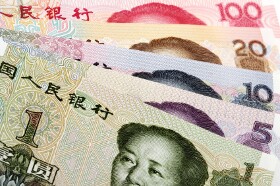The Chinese yuan is trading flat against the US dollar, but it has topped 8.0 against the euro to kick off the trading week. The yuan is coming off its best quarter in more than a decade as analysts warn think the yuan could become the next safe-haven currency amid volatility. Can the yuan test 6.6 in the final quarter of 2020?
The broader financial market has been surprised by the yuan’s appreciation in the three months ending September 30, becoming one of the top-perform currencies in the world. Many analysts had anticipated growth in the yuan, but its performance has surpassed expectations. The yuan advanced more than 3.25% against the greenback in Q3, adding to its year-to-date rally of close to 2.5%.
What is driving the yuan? First, the Chinese government has, based on internal data, effectively tackled the pandemic. Second, the economy is one of the few major markets to recover in the aftermath of the COVID-19 public health crisis. Last week, manufacturing activity came in better than expected in September, and the World Bank forecast that Beijing would be one of the few Asian nations to record growth this year.
On the data front, the private-sector Caixin September readings of the services and composite purchasing managers’ indexes (PMI) will be released later this week. Foreign exchange reserves will also be published. The critical trade data for September will come out next week.
It should be noted, according to Bloomberg numbers, that the yuan is trading as much as the Swiss franc or British pound sterling each day. Between 2016 and 2019, yuan trading in forex markets increased by 41% to approximately $285 billion per day.
Does this mean the good times will last forever for the yuan? Not quite. The consensus is that US-China trade tensions, as well as the result of the 2020 US presidential election, could weigh on the currency in the near- to medium-term. Chang Wei Liang, a macro strategist at DBS in Singapore, told the business news network that external factors could make the yuan vulnerable to volatility:
Political debate will naturally focus on the U.S.-China trade relations, with possible questions over the continuity of the Phase one deal, and whether new trade measures are likely to be considered. This could stoke tensions, and keep yuan traders wary.
Meanwhile, the People’s Bank of China (PBoC) recently kept its benchmark lending rate for corporate and household loans unchanged at 3.85% for the one-year loan prime rate (LPR). The central bank also left the five-year LPR steady at 4.65%.
The PBoC also reported that bonds issued by the nationâs private companies in the interbank market topped $51 billion in the January-to-August period, up 64% year-over-year.
The USD/CNY currency pair was unchanged at 6.7908 at 16:47 GMT on Monday. The EUR/CNY surged 0.6% to 8.0047, from an opening of 7.9559.
If you have any questions, comments, or opinions regarding the Chinese Yuan, feel free to post them using the commentary form below.
